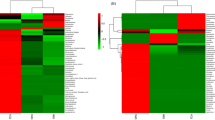Abstract
Maotai-flavor liquor, a famous traditional Chinese drink, is distilled from fermented sorghum in the southern province of China. Moreover, it is of interest as one of the few examples of liquor distilled from the product of a fermentation using a wild microflora starter. Daqu is the starter of this fermentation process. Daqu is a mixture of two components: milled wheat and a complex microbial community. The composition and the effects of this microbial group are largely unknown. In this study, we have analysed the constituents of the microbial community and the development of microorganisms in the industrial Daqu preparation and ripening process. More than 200 colonies were isolated and characterized. The isolates were discriminated by phenotypic and conventional biochemical taxonomic methods. The results revealed the presence of bacteria, moulds and yeasts. Bacteria consist of Bacillus, Acetobacter, Lactobacillus, and Clostridium, among which Bacillus strains were found to be predominant. Moulds consisted of Aspergillus, Mucor, Rhizopus, Monascus and Trichoderma, and Aspergillus strains were found to be predominant in the six different biotypes. Yeasts comprised Saccharomyces, Hansenula, Candida, Pichia, and Torulaspora. The most frequently isolated yeasts belonged to the genus Saccharomyces. The microbial diversity shift showed that the microbial genera changed with increasing ripening time. Knowledge of the microbial diversity in Daqu provides a basis for microflora management and understanding of the role of microbes in the Daqu production process, and the contribution of Daqu performed as a starter culture to Maotai-flavor liquor.

Similar content being viewed by others
References
Banerjee M, Sarkar PK (2003) Microbiological quality of some retail spices in India. Food Research International 36:469–474. doi:10.1016/S0963-9969(02)00194-1
Barnett HL, Hunter BB (1972) Illustrated Genera of imperfect fungi. 3rd edn. Burgess Publishing Co. Minneapolis, pp 53–180
Barnett JA, Payne RW, Yarrow D (2000) Yeast: characteristics and identification. 3rd edn. Cambridge University Press, Cambridge, UK
Beaumont M (2002) Flavouring composition prepared by fermentation with Bacillus spp. Int J Food Microbial 75:189–196. Medline. doi:10.1016/S0168-1605(01)00706-1
Bramorski A, Christen P, Ramirez M, Soccol CR, Revah S (1998) Production of volatile compounds by the edible fungus Rhizopus oryzae during solid state cultivation on tropical agro-industrial substrates. Biotechnol Lett 20:359–362. doi:10.1023/A:1005323229125
Buchanan RM Gibbons NE (1974) Bergey’s Mannual of Determinative Bacteriology, 8th edn. Williams and Wilkins Company, Baltimore, ISBN 0-68301117-0
Christen P, Bramorski A, Revah S, Soccol CR (2000) Characterization of volatile compounds produced by Rhizopus strains grown on agro-industrial solid wastes. Bioresource Technology 71:211–215. doi:10.1016/S0960-8524(99)00084-X
Dong XZH, Cai MY (2000) General methods of identifying bacteria. Science Publishing Press, Beijing
FDA (1984) FDA bacteriological analytical manual, 6th edn. Association of Official Analytical Chemists, Arlington, Virginia
Feng XM, Larsen TO, Schnurer J (2007) Production of volatile compounds by Rhizopus oligosporus during soybean and barley tempeh fermentation. Int J Food Microbiol 113:133–141. Medline. doi:10.1016/j.ijfoodmicro.2006.06.025
Fleet GH, Heard GM (1993) Yeasts growth during fermentation. In: Fleet GM (ed) Wine microbiology and biotechnology. Harwood Academic Publishers, Chur
Frateur J (1950) Essai sur la systematique des Acetobacters. La Cellule 53, 287–392. Cited in Bergey’s manual of systematic bacteriology
Frazier WC, Westhoff DC (1988) Food Microbiology, 4th edn. McGraw-Hill Book Co., New York, pp 17–31. ISBN 0070219214
Fu YS, Wang ZY, Deng XC (2000) Ecology of liquor-making industry and its development. Liquor-making Science and Technology 1:22–23
Guo LH, Liu L, Yi C (eds) (1999) The first Jiaochi to produce liquor in China. Chinese Workman Publishing Company, Beijing, pp 32–45
Kurtzman CP, Fell JW (1998) The yeasts. A taxonomic study, 3rd edn. Elsevier Publishers, Amsterdam, Netherlands. ISBN 0-444-81312-8
Li ZQ, Guo F (eds) (2003) Morphology and taxonomy of monascus. Chinese Light Industry Publishing Company, Beijing
Liu Z, Dong XZ, Xu Y, Bai F Y, Yang DC, Zhang HF, Liu ZP, Xin MX, Jiang N, Wang QH, Men DP, Jia PX,Yuan M, Yan XW (2002) Current microbiology. Science Publishing Companies, Beijing, pp 100–106
Man JC, de Rogosa M, Sharpe ME (1960) A medium for the cultivation of Lactobacilli. Journal of Applied Bacteriology 23:130–135
Nout MJR, Bakshi D, Sarkar PK (1998) Microbiological safety of kinema, a fermented soya bean food. Food Control 9:357–362. doi:10.1016/S0956-7135(98)00126-1
Oda K, Kakizono D, Yamada O, Iefuji H, Akita O, Iwashita K (2006) Proteomic analysis of extracellular proteins from Aspergillus oryzae grown under submerged and solid-state culture conditions. Appl Environ Microbiol 72:3448–3457. Medline. doi:10.1128/AEM.72.5.3448-3457.2006
Qian S, Ru XH (eds) (1997) Flavour components and chemistry of Chinese liquors. Chinese Light Industry Publishing Company, Beijing, pp 178–180
Qin HZ (1997) Science and technology of Chinese liquor brewing. Chinese Light Industry Publishing Company, Beijing, pp 82–121
Rojas V, Gil JV et al (2001) Studies on acetate ester production by non-Saccharomyces wine yeasts. Int J Food Microbiol 70:283–289. Medline. doi:10.1016/S0168-1605(01)00552-9
Rosgaard L, Pedersen S, Meyer AS (2007) Comparison of different pretreatment strategies for enzymatic hydrolysis of wheat and barley straw. Appl Biochem Biotechnol 143:284–296. Medline. doi:10.1007/s12010-007-8001-6
Sun C, Zhang D (1994) Research on analysis of important microbes in cellar clay and practical application of cultivate liquid cellar clay by using multi-microbes ferment together. Liquor making Sci Technol 6:18–21
Speck ML (ed) (1984) Compendium of methods for the microbiological examination of foods, 2nd edn. American Public Health Association, New York
Zhang WX, Qiao ZW, Xiang WL, Zhang LY, Hu C, Wang ZY, Hu YS (2004) Micro-ecological research progress of the cellar of Chinese flavour liquor. Liquor Making 31:31–35
Acknowledgements
This study was financially supported by the grants (Nos. 20776115 and 20576100) of the Natural Science Foundation of China (NSFC).
Author information
Authors and Affiliations
Corresponding author
Rights and permissions
About this article
Cite this article
Wang, Cl., Shi, Dj. & Gong, Gl. Microorganisms in Daqu: a starter culture of Chinese Maotai-flavor liquor. World J Microbiol Biotechnol 24, 2183–2190 (2008). https://doi.org/10.1007/s11274-008-9728-0
Received:
Accepted:
Published:
Issue Date:
DOI: https://doi.org/10.1007/s11274-008-9728-0




